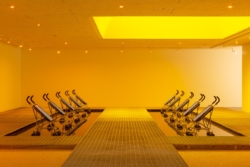What are you listening at the moment?
The noise of the hair dryer switched on in the bathroom, two TVs in the living room, one in the bedroom, the extractor hood and a background song that doesn’t captivate me or disturb me, played by a bluetooth speaker placed in the stove to reverberate. The entirety of these elements combined is an orchestra that reaches perfection when none of such instruments overrides the other, until it becomes the background to my actions, a soundscape of everyday life, for hours and hours until I decide to move or change some. It’s not just the sound but also the colours, images or contents that I indirectly absorb.
Which was your first fetish experience? What drew you to this scene in particular? Do you personally practice it as lifestyle?
Well, the encounter with the Lord and the Catholic schools, these were my first fetish experiences. After all, we are well aware how much corporal punishment and submission appeal to religion. By discovering God, I got to know fetishism! When I created Decadence there was no real fetish scene, especially in Italy; I was intrigued by the looks, the sense of mystery and unknown that one could sense from that world.
Fetishism as a deviation of the drive or sexual instinct (Freud) or as an elevation where the erotic affirms the inner life of man and, as such, is sacred (Bataille). To which school of thought do you feel more close to?
None of the above, I have my own personal vision, ideas that come from my different interests and fields of study. As I said before, I attended Catholic schools, so the religious theme has always been part of my life; from there, I approached esotericism, I obtained a degree in metaphysics and high competence in bibliology. Precisely starting from these researches, I began to write reflections on God, magick studies, passions and experiences met while creating Madonne.
Tell us a bit about the various areas within Decadence. Do you feel that the needs/requests/fetishes and people’s interests have changed with time?
Today, Decadence unites several subcultures under the same roof, varied but united by a passion for obscure and extreme forms of art. Initially, such realities were divided, the strongest and most characterised subcultures being Goth and BDSM. Over the years, the apparel of both genres has become similar. From leather to latex, it is possible now to talk about a simil-fetish clothing, a distinctive dress code that embraces all such different realities. You can hear people say “I dress in Decadence style”.
Nowadays, in a post–Fifty Shades of Grey-world fetishistic themes and iconography have been increasingly integrated into the mainstream more than ever before. Let’s take for example latex, long seen as something niche, that used to be taboo and that now is celebrated with hyper-visibility on the runway and in some of the most commercial fashion magazines. What is your take on this phenomenon, is it a positive one for those true and devoted to the scene?
The explosion of latex, both in the media and on the catwalks, was something that also benefited BDSM lovers. Compared to a few years ago, prices have now decreased and the availability of this type of clothing has increased. Before, very few people knew how to handle the material and the clothes were custom made. Everyone has a fetish, BDSM is something rooted in all of us. I believe that an interest in BDSM clothing can push people to hang around certain environments and discover their passions (their fetishes). Those with a true alternative soul will always stand out in style with a touch of uniqueness. I also want to add that before 50 Shades of Gray there was Pan Play Decadence, in cinemas and festivals, which won several awards and explored the obsessions connected to the body and mind of some of Decadence’s most loyal protagonists.
What sexual taboos you feel are yet to be challenged?
All sexuality still is a taboo, it is a subject so scrutinised, judged, that one feels obliged to have to communicate one’s sexual preferences or gender publicly, in order to be figured out and accepted.
Which films/books/music/artists influenced most your work, lifestyle and way of thinking so far?
The Bible, Mel Gibson’s “The Passion of the Christ”, William Friedkin’s “Cruising”, with Al Pacino sent deep undercover into leather bars, which song track ‘Walk the Night’ has been a Decadence hit.
Reveal us a secret.
I don’t like heels, the whole body appears to me as in a sort of aesthetic aniseikonia. I have a fetish for a certain kind of leg, a shape that’s clear in my mind, of which I have a private collection of photos taken by myself that could one day become an exhibition. I also don’t like naked bodies, even if they are perfect. I think that beauty, as you at Nasty know well, passes through the dress.






















